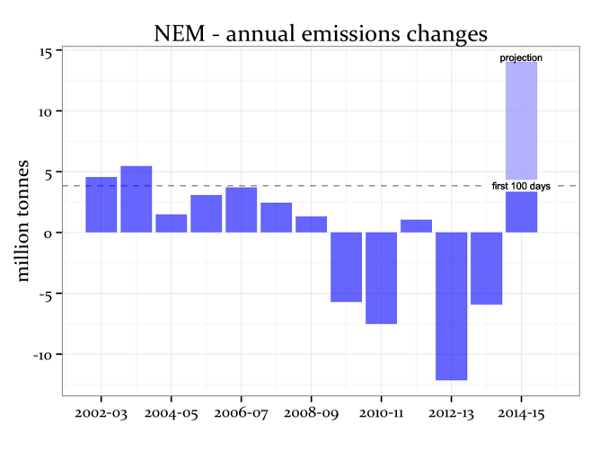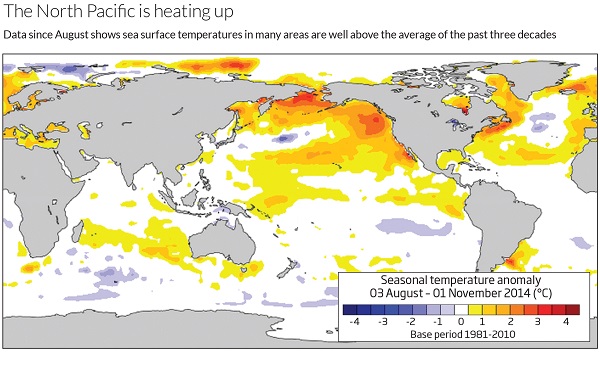1. Australia’s coal and gas exports are being left stranded
Just four countries account for 80% of Australia’s fossil fuel exports – China, Japan, Korea and India.
China is on the verge of “peak coal”, rebalancing the economy away from energy intensive industry and introducing a national emissions trading scheme.
Japan is on an energy efficiency drive to reduce its fuel import bill.
Korea has introduced a tax on coal of AU$18 per tonne and is finalising an emissions trading scheme.
India has doubled its tax on coal which funds renewable energy projects and has signalled its intention to stop importing coal within 2-3 years.
Official forecasts are in denial.
2. Are Australian and US climate targets the same?
Environment minister Greg Hunt, Radio National, November 17:
If you use the full Kyoto period — 1990 to 2020 — the US is minus 5% and Australia is almost exactly the same.
Joe Hockey made a similar statement that “If you compare apples with apples, the American position and our position on reductions are effectively the same.”
The comparisons are complex, because the starting and finishing dates are different, so are the population increases. Moreover Australia has forestry and tree clearing in the mix.
Malte Meinshausen and Anita Talberg make the necessary adjustments and find:
An apples-with-apples comparison shows that Australia lags far behind the United States in efforts to reduce greenhouse gas emissions from its energy, transport and industrial sectors.
To match US efforts, Australia would have to increase its 2020 ambitions from the current 5% below 2000 to 21% or even 29%, depending on whether different population growth is taken into account, or not.
In short, they lie!
3. The genius of Tony Abbott’s stance on climate

At New Matilda Tom Allen comments on Tom Switzer’s claim the Abbott is a climate change genius. Switzer is a climate change denialist, so we won’t bother with that! Allen finds Abbott has proved one thing – that a carbon tax works!
Abbott
will be remembered as the Prime Minister who proved that the carbon tax worked. After it was introduced, Australia’s carbon dioxide emissions fell, the economy continued to grow and the sky remained in place.
When Abbott repealed it and the country’s emissions began to rise again, using Australia as a vast laboratory, Abbott confirmed it: carbon taxes work.
4. Record growth in electricity sector emissions
Abbott’s genius is demonstrated by this graph of emissions change from electricity production:

The reductions started well before the carbon ‘tax’, but whatever the reason Abbott seems to have made a difference.
WORST. PRIME MINISTER. EVER!!
As Tom Allen said, it’s nothing personal.
The worst things about him are his policies, and his stance on climate change is worst of all.
5. Record-breaking ocean temperatures
The world’s oceans are the hottest they’ve ever been in the modern record, especially in the northern Pacific.
In July this year, ocean surfaces were 0.55 °C above the average since 1890, just beating the previous record of 0.51 °C in 1998. In the North Pacific, the temperatures were about 0.8 °C above average, which is 0.25 °C warmer than the 1998 peak.

No explanation is given as to why this pattern has emerged. However, it does seem to be disrupting the development of an El Niño. Small mercy, because the northern Pacific warming has effects similar to an El Niño:
This includes more hurricanes in the Pacific, as well as more storms curling over into mainland US. Meanwhile, there have been fewer hurricanes in the Atlantic, just as happens during El Niño. Elsewhere, dry conditions have occurred across Australia, and the Indian monsoon was delayed – effects all arising from warm oceans, despite the lack of an El Nino event.
6. Turn down the heat : confronting the new climate normal
This is volume 2 of 2 of a report prepared for the World Bank by the Potsdam Institute for Climate Impact Research and Climate Analytics, and hence highly authoritative. The lead author was Hans Joachim Schellnhuber of the Potsdam Institute.
It’s a massive 320 page report. This is from the Foreword:
There is growing evidence that warming close to 1.5°C above pre-industrial levels is locked-in to the Earth’s atmospheric system due to past and predicted emissions of greenhouse gases, and climate change impacts such as extreme heat events may now be unavoidable.
As the planet warms, climatic conditions, heat and other weather extremes which occur once in hundreds of years, if ever, and considered highly unusual or unprecedented today would become the “new climate normal” as we approach 4°C—a frightening world of increased risks and global instability.
The consequences for development would be severe as crop yields decline, water resources change, diseases move into new ranges, and sea levels rise. Ending poverty, increasing global prosperity and reducing global inequality, already difficult, will be much harder with 2°C warming, but at 4°C there is serious doubt whether these goals can be achieved at all.
That’s about as far as I could get tonight. Climate Progress has a post.


In opposition Abbott helped drive emissions down by exaggerating the cost of a carbon tax and scaring people into doing things to reduce the effect of the carbon tax. In government he may have convinced some people that the carbon tax savings will be much higher than actual and hemce it was not worth doing anything to reduce emissions.
The real impact of Abbott and state premiers who are openly hostile to climate action has been to stop new RET driven investment in large scale utilities and generally make things hard for solar etc.
The good news is that the feds, Qld vic and Tasmania tea party governments are all starting to look like oncers.
Here is some good news on the ICE front.
http://www.foxnews.com/leisure/2014/11/24/compact-rotary-engine-is-petite-powerhouse/
This little engine to my thinking is the new front runner as the off grid dark day solution. respectably efficient, suitable to run on natural gas, quiet, low vibration, compatible power output. Other articles suggest 5 BHP for the production units which will deliver a healthy 2.5 Kw from a compact and low cost generator solution.
This fits my off grid formula of a 4.5 PVT (photo voltaic thermal combination) system with 16 kwhrs of storage, 2.2 to 2.5 Kw backup generator and gas for cooking and to power the backup. This covers all of the bases and you can get rid of those wires, and the power bill.
I am also researching solar air conditioning using the absorptive ammonia cycle. It looks very positive. The knockers point to ammonia explosions, but these turn out to be extremely rare, and enclosed basement situations. The solar air conditioner is an external fixture so that any leaks vent safely outside, and I have limited the risk by making the system modular Other system utilise Lithium Bromide as the operative medium, but I prefer to leave consumption of lithium for the battery industry.
My other interest area is in small aircraft. There is good news there too, and from RMIT no less. Have a look at the video in this article, it should leave you in complete awe at how nature finds solutions to complex problems.
http://blog.cafefoundation.org/feathers-flight-inspire-anti-turbulence-technology/
Turbulent air is a huge problem for light aircraft and this may seem like a nothing issue for city dwellers. But country folk use light aircraft in many ways, and they are a necessary part of economical farming.
Here is an interesting thought from a commenteer at skeptical science.
“Republicans (LNP in our intelligence forsaken country) have boxed themselves in. They have no other choice but to repeal the Laws of Thermodynamics.”
For anyone who interested in the technologies here is a piece that gives a very definitive evaluation of scope for solar airconditioning. This Yazaki unit is not yet scaled for individual dwellings but the information verifies the how effective this technology will be once the fog lifts on the complete solar house. “water fired” means powered by hot water ie water heated by energy absorbing solar collectors or water heated by gas during non solar periods.
http://www.yazakienergy.com/waterfiredperformance.htm
The other technology that I have only just discovered is that of magnetic refrigeration. Sounds weird but it is rock solid. Add the usual prefixes to this link
“http//www.” racplus.com/news/commercial-and-domestic-magnetic-refrigeration-launches-imminent/8649939.article
I’m still geeking out over this and that I have not heard anything about this especially as I have a lifetime of involvement with the appliance industry.
Apart from a 50% (yes, five zero percent) reduction in energy consumption for the household refrigerator, this system does not require refrigerant ie no ozone hole creating gasses.
So how is that off grid solar house shaping up?
High efficiency PVT panels provide both electricity and hot water from the same hardware. If you have 4.5 kw PVT panels you will get 4.5 kw peak of electricity plus up to 9 kw energy equivalent thermal energy in the form of hot water (more than sufficient to charge the water heater and run the Yazaki absorptive air conditioner. A 12 kwhr battery bank backed up with a 2.5 kw Liquid Piston gas powered engined generator set (with a noise and vibration equivalent very near to that of a refrigerator or conventional air conditioner running) providing cost effective 24/7 low solar energy back up and with dual energy storage where the gas is bottled. And now with the imminent prospect of Camfridge magnetic refrigeration reducing battery drain by 50% supporting the energy savings from LED lighting, high energy efficiency “home insulation” (now cancelled thanks to the interference of Abbott’s “support the coal industry” stupidity), double glazing (we did not get to that one), and gas cooking appliances, the household night time energy needs are down to very low levels. Not to mention the fact that millions of people are absorbing large chunks of their time with very low energy consumption tablet computers rather than other more energy consuming pastimes (Skype not flight).
I will update my solar house spread sheet soon with the new information that is becoming more defined with empirical evidence rather than estimates and assumptions and include all aspects, including vehicles.